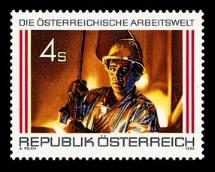
| Austria Cafe |

Economy
|
Since the beginning of 1995 Austria has been a member of the European Union . This step has accelerated the process of economic adjustment initiated when Austria joined the European Economic Area (EEA) in January 1994. Membership of the EU offers Austria the opportunity to enlarge the scope of its integration above and beyond purely economic matters. The challenges that face Austria in the future will be securing the greatest possible congruence of its economic policy with common EU policies, most notably in the fields of trade, agriculture, regional development, taxation and monetary policy. Austria is in a strong position here, being one of the wealthiest and most stable of the EU member countries. Its economic system, a free market economy with a strong emphasis on social factors favouring the economically less privileged, will be retained in the EU, as will the successful system of Economic and Social Partnership, which has traditionally played an important conciliatory role in the country's wages and price policy. Having reached the required level of convergence, Austria is one of the 11 EU countries which will enter upon stage 3 of the Economic and Monetary Union (EMU) from the beginning of the year 1999. From this point in time, the euro will be the currency of the member countries taking part in EMU, and it will replace their national currencies at the appropriate exchange rates. Austria is a highly developed industrialised nation with an important service sector. The foremost industries are foodstuffs and luxury commodities, mechanical engineering and steel construction, chemicals and vehicle manufacturing. Within the vehicle sector, the production of engines and transmissions is the most important area, accounting for an export quota in excess of 90%. Austria manufactures some 800,000 engines per annum for many major car manufacturers. In the electronic engineering field, Austria has made a name for itself with the production of customised electronics products like microprocessors and integrated circuits for airbags, ABS braking systems and components for Airbus airliners and for high-speed trains etc.
In 1997 the primary sector (agriculture and forestry) accounted for only 2.8% of Austria's gross domestic product, while the secondary sector (commodities manufacture, energy, mining) accounted for 34.8%, and the tertiary sector (services, banking, public services, commerce, transport, tourism) accounted for 62.5% of GDP. Some 18% of Austria's surface area is covered by farm land, 27% by grassland and 47% by woods and forests. 41% of Austria's total area is suitable for agriculture. 5% of all employed persons in Austria work in agriculture and forestry. With its 20,000 organic farmers, Austria occupies a leading position in this branch of agriculture in Europe. In the field of raw materials and energy generation Austria can draw on abundant resources. It has deposits of iron ore, non-ferrous metals, important minerals and earths. However, the constant growth of the industrial sector necessitates supplementary imports to an ever increasing degree. This is also true of fuels and energy and of the electricity generating industry. Austria has its own resources of oil and natural gas. Austria is the European Union's number one generator of hydro-electric power. The predominant feature of Austria's industrial and commercial sectors is its high proportion of medium-size enterprises. Austrian industry covers every branch of manufacture, from basic goods to the labour-intensive production of finished goods. Ever greater importance attaches to plant construction (encompassing the planning, delivery and assembly of turn-key industrial facilities including the requisite operational expertise). This field is strongly export-oriented, as is the electronics sector (e.g. the production of integrated circuits). Austria's handicrafts are famous throughout the world - most notably fine hand-crafted items, costume jewellery, ceramics and glassware. One of the areas in the tertiary sector which reports high rates of foreign currency earnings is tourism (1997: 134.7 billion Schillings). As an export-oriented country, Austria maintains a wide-ranging and highly diverse foreign trade system. It trades with some 150 countries. The countries of the European Union account for some two thirds of Austria's foreign trade
In the years immediately following the opening of Eastern Europe, some 40% of all direct foreign investments in that part of the continent came from Austria. The trend reached its apex in the early nineties.By 1997 the figure had declined to 5.3%. In the same year Austria's exports to Eastern European countries increased by 33.7% against 1996 to reach a total of 126 billion Schillings, while imports climbed by 22.4% to total 87.2 billion Schillings. The major trading partners were Hungary, the Czech Republic and Poland. An important branch of Austria's foreign trade sector is transit trade, in conjunction with the mediation of East-West trading transactions. In 1997 the mean unemployment rate in Austria stood at 7.1% or 4.4% calculated on EU criteria, and the mean gross monthly income of dependently employed persons at 28,700 Schillings (compared with 28,200 Schillings in the previous year). Austria's balance of payments shows a permanent deficit in the trade balance, while the services balance (tourism) is generally active, offsetting part of the trade balance deficit. The Austrian currency, the Schilling, is fully convertible and ranks as one of the world's hardest currencies. The mean US$ exchange rate in 1997 was ATS 12.20. On 31 December 1998 at 12.30 p.m. the final exchange rates for the Euro were announced. The table shows the rates for the eleven Euro countries. 1 Euro=
In the world political arena, Austria has established itself as an international place of encounter, as exemplified by the countless summit meetings and international conferences which it has hosted. In the same measure, Austria is assuming increasing importance in the transport sector as a key communications hub between the economic areas of Europe. A factor of growing importance is the European energy transit network (the transport of oil, natural gas and electricity) through Austria. |